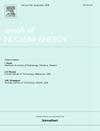238U在分辨共振区的中子共振积分分析
IF 1.9
3区 工程技术
Q1 NUCLEAR SCIENCE & TECHNOLOGY
引用次数: 0
摘要
中子共振数据在核工程应用中具有重要意义。旨在有效评估实验测量和评估之间的差异,包括ENDF/B-VIII。1、JEFF-3.3、JENDL-5、CENDL-3.2、BROND-3.1。建立了一种基于导数法和高斯滤波的共振峰识别技术,对解析共振区域内实验和评价数据的两种共振特性(积分值和中心能量)进行系统分析。本文分析了238U两种性能的偏差。在中子能量低于20kev的情况下,发现了1500多个中子总反应和俘获反应的共振峰。结果表明,(n, t)共振的中心能量与实验数据吻合较好,而(n, γ)共振的中心能量随能级的升高而偏离较大;(n, γ)和(n, t)的共振积分实验值与计算值之间存在显著偏差,具有较好的一致性。目前的工作有效地识别了未来需要改进的能量区域。本文章由计算机程序翻译,如有差异,请以英文原文为准。
Neutron resonance integral analysis of 238U within resolved resonance region
Neutron resonance data are significant importance for applications in nuclear engineering. Aimed to assess the discrepancies efficiently between the experimental measurements and evaluations, including ENDF/B-VIII.1, JEFF-3.3, JENDL-5, CENDL-3.2 and BROND-3.1. A resonance peak identification technique based on derivative method and Gaussian Filter is established to conduct systematic analysis on two resonance properties (integral values and central energy) of the experimental and evaluated data within the resolved resonance region. The deviations of the two properties of 238U are analyzed in this work. More than 1500 resonance peaks of neutron total and capture reactions are identified below neutron energy 20 keV. As a result, the evaluated central energies of (n, tot) resonances exhibit excellent agreement with experimental data, while those of (n, ) resonances show increasing deviation with rising energy levels; significant deviations of resonance integrals exist between experimental and evaluated data of (n, ), and (n, tot) demonstrate a better consistency. The current work efficiently identifies the energy regions that require improvement in the future.
求助全文
通过发布文献求助,成功后即可免费获取论文全文。
去求助
来源期刊

Annals of Nuclear Energy
工程技术-核科学技术
CiteScore
4.30
自引率
21.10%
发文量
632
审稿时长
7.3 months
期刊介绍:
Annals of Nuclear Energy provides an international medium for the communication of original research, ideas and developments in all areas of the field of nuclear energy science and technology. Its scope embraces nuclear fuel reserves, fuel cycles and cost, materials, processing, system and component technology (fission only), design and optimization, direct conversion of nuclear energy sources, environmental control, reactor physics, heat transfer and fluid dynamics, structural analysis, fuel management, future developments, nuclear fuel and safety, nuclear aerosol, neutron physics, computer technology (both software and hardware), risk assessment, radioactive waste disposal and reactor thermal hydraulics. Papers submitted to Annals need to demonstrate a clear link to nuclear power generation/nuclear engineering. Papers which deal with pure nuclear physics, pure health physics, imaging, or attenuation and shielding properties of concretes and various geological materials are not within the scope of the journal. Also, papers that deal with policy or economics are not within the scope of the journal.
 求助内容:
求助内容: 应助结果提醒方式:
应助结果提醒方式:


